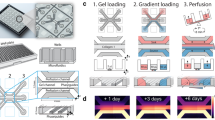Abstract
Microfluidic systems have emerged as an important technology for modeling cellular microenvironments in vitro. These systems enable unprecedented levels of control of chemical gradients, fluid flow, and localized 3-D extracellular matrices (ECM), all of which can be integrated to provide a physiologically relevant context for studying complex cellular processes such as angiogenesis. Here, we describe the design and use of microfluidic systems for reproducing the dynamic events of vascular morphogenesis.
Access this chapter
Tax calculation will be finalised at checkout
Purchases are for personal use only
Similar content being viewed by others
References
Inamdar NK, Borenstein JT (2011) Microfluidic cell culture models for tissue engineering. Curr Opin Biotechnol 22:681–689
Stone HA, Stroock AD, Ajdari A (2004) Engineering flows in small devices: microfluidics toward a lab-on-a-chip. Annu Rev Fluid Mech 36:381–411
Whitesides GM (2006) The origins and the future of microfluidics. Nature 442:368–373
Duffy DC, McDonald JC, Schueller OJA, Whitesides GM (1998) Rapid prototyping of microfluidic systems in poly(dimethylsiloxane). Anal Chem 70:4974–4984
Whitesides GM, Ostuni E, Takayama S, Jiang X, Ingber DE (2001) Soft lithography in biology and biochemistry. Annu Rev Biomed Eng 3:335–373
El-Ali J, Sorger PK, Jensen KF (2006) Cells on chips. Nature 442:403–411
Young EW, Simmons CA (2010) Macro- and microscale fluid flow systems for endothelial cell biology. Lab Chip 10:143–160
Kim L, Toh YC, Voldman J, Yu H (2007) A practical guide to microfluidic perfusion culture of adherent mammalian cells. Lab Chip 7:681–694
Walker GM, Zeringue HC, Beebe DJ (2004) Microenvironment design considerations for cellular scale studies. Lab Chip 4:91–97
Mosadegh B, Huang C, Park JW, Shin HS, Chung BG, Hwang SK et al (2007) Generation of stable complex gradients across two-dimensional surfaces and three-dimensional gels. Langmuir 23:10910–10912
Shamloo A, Heilshorn SC (2010) Matrix density mediates polarization and lumen formation of endothelial sprouts in VEGF gradients. Lab Chip 10:3061–3068
Young EW, Wheeler AR, Simmons CA (2007) Matrix-dependent adhesion of vascular and valvular endothelial cells in microfluidic channels. Lab Chip 7:1759–1766
Song JW, Gu W, Futai N, Warner KA, Nor JE, Takayama S (2005) Computer-controlled microcirculatory support system for endothelial cell culture and shearing. Anal Chem 77:3993–3999
Andersson H, Berg A (2004) Microfabrication and microfluidics for tissue engineering: state of the art and future opportunities. Lab Chip 4:98–103
Song JW, Bazou D, Munn LL (2012) Anastomosis of endothelial sprouts forms new vessels in a tissue analogue of angiogenesis. Integr Biol (Camb) 4:857–862
Song JW, Munn LL (2011) Fluid forces control endothelial sprouting. Proc Natl Acad Sci U S A 108:15342–15347
Song JW, Daubriac J, Tse JM, Bazou D, Munn LL (2012) RhoA mediates flow-induced endothelial sprouting in a 3-D tissue analogue of angiogenesis. Lab Chip 12:5000–5006
Qin D, Xia Y, Whitesides GM (2010) Soft lithography for micro- and nanoscale patterning. Nat Protocols 5:491–502
Morgan JP, Delnero PF, Zheng Y, Verbridge SS, Chen J, Craven M et al (2013) Formation of microvascular networks in vitro. Nat Protocols 8:1820–1836
Walker GM, Beebe DJ (2002) A passive pumping method for microfluidic devices. Lab Chip 2:131–134
Vestweber D (2008) VE-cadherin: the major endothelial adhesion molecule controlling cellular junctions and blood vessel formation. Arterioscler Thromb Vasc Biol 28:223–232
Huh D, Mills K, Zhu X, Burns MA, Thouless M, Takayama S (2007) Tuneable elastomeric nanochannels for nanofluidic manipulation. Nat Mater 6:424–428
Chaw KC, Manimaran M, Tay FE, Swaminathan S (2007) Matrigel coated polydimethylsiloxane based microfluidic devices for studying metastatic and non-metastatic cancer cell invasion and migration. Biomed Microdevices 9:597–602
Huang CP, Lu J, Seon H, Lee AP, Flanagan LA, Kim HY et al (2009) Engineering microscale cellular niches for three-dimensional multicellular co-cultures. Lab Chip 9:1740–1748
Vickerman V, Blundo J, Chung S, Kamm R (2008) Design, fabrication and implementation of a novel multi-parameter control microfluidic platform for three-dimensional cell culture and real-time imaging. Lab Chip 8:1468–1477
Atherton A, Born GV (1973) Relationship between the velocity of rolling granulocytes and that of the blood flow in venules. J Physiol 233:157–165
Munn LL (2003) Aberrant vascular architecture in tumors and its importance in drug-based therapies. Drug Discov Today 8:396–403
Acknowledgement
We acknowledge support from grants from the National Institutes of Health: R01CA149285 (LLM) and T32CA073479.
Author information
Authors and Affiliations
Corresponding author
Editor information
Editors and Affiliations
Rights and permissions
Copyright information
© 2015 Springer Science+Business Media New York
About this protocol
Cite this protocol
Song, J.W., Bazou, D., Munn, L.L. (2015). Microfluidic Model of Angiogenic Sprouting. In: Ribatti, D. (eds) Vascular Morphogenesis. Methods in Molecular Biology, vol 1214. Humana Press, New York, NY. https://doi.org/10.1007/978-1-4939-1462-3_15
Download citation
DOI: https://doi.org/10.1007/978-1-4939-1462-3_15
Published:
Publisher Name: Humana Press, New York, NY
Print ISBN: 978-1-4939-1461-6
Online ISBN: 978-1-4939-1462-3
eBook Packages: Springer Protocols




